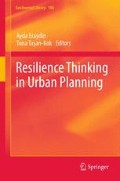Abstract
The very features that make cities feasible and desirable – their architectural structures, population concentrations, places of assembly, and interconnected infrastructure systems – also put them at high risk to floods, earthquakes, hurricanes and terrorist attacks (Godschalk 2003).
Access this chapter
Tax calculation will be finalised at checkout
Purchases are for personal use only
Notes
- 1.
The average elevation of the area is approximately +3.25 m above Amsterdam Ordnance Datum (NAP) with some parts as low as +2.50 m NAP, which results in limited flooding typically once or twice a year.
- 2.
The new National Spatial Planning Act came into effect on 1 July 2008, replacing the previous act from 1965.
- 3.
The two main dimensions of urban resilience discussed above are (1) the system’s robustness (or its strength to withstand disturbance) and (2) the speed with which this recovery of function is achieved (or flexibility of response).
- 4.
Preparations for a climate adaptation programme in the Rijnmond-Drechtsteden Delta involve cooperation between national and regional governments.
References
Biesbroek, R., Swart, R. J., & van der Knaap, W. M. J. (2009). The mitigation-adaptation dichotomy and the role of spatial planning. Habitat International, 33(3), 230–237.
Davoudi, S. (2012). Climate risk, resilience and security: New ways of seeing ‘the environment’ in the English planning system. European Planning Studies, 20(1), 49–69.
de Vries, J. (2006). Climate change and spatial planning below sea-level: Water, water and more water. Planning Theory and Practice, 7(2), 223–227.
Godschalk, D. R. (2003). Urban hazard mitigation: Creating resilient cities. Natural Hazards Review, 4(3), 136–143.
Hajer, M. A. (1995). The politics of environmental discourse. Oxford: Oxford University Press.
Kabat, P., Vellinga, P., Aerts, J., Veraart, J. A., & van Vierssen, W. (2005). Climate proofing the Netherlands. Nature, 438, 283–284.
Lagendijk, A. (2003). Towards conceptual quality in regional studies: The need for subtle critique – A response to Markusen. Regional Studies, 37(6/7), 719–727.
Leichenko, R. (2011). Climate change and urban resilience. Current Opinion in Environmental Sustainability, 3(3), 164–16810.1016/j.cosust.2010.12.014.
Municipality of Rotterdam. (2010). Rotterdam sustainability guide. Rotterdam: Department of Public Works, Municipality of Rotterdam.
Nicholls, R. J., Hanson, S., Herweijer, C., Patmore, N., Hallegatte, S., Corfee-Morlot, J., Chateau, J., & Muir-Wood, R. (2007). Ranking of the world’s cities most exposed to coastal flooding today and in the future (OECD Environment Working Paper No. 1) (ENV/WKP(2007)1). Paris: OECD.
Priemus, H. (2004). Spatial memorandum 2004: A turning point in the Netherlands’ spatial development policy. Tijdschrift voor Economische en Sociale Geografie, 95(5), 578–583.
Swart, R. J., & Raes, F. (2007). Making integration of adaptation and mitigation work: Mainstreaming into sustainable development policies? Climate Policy, 7(4), 288–303.
Taşan-Kok, T., & Baeten, G. (Eds.). (2011). Contradictions of Neoliberal Planning: Cities, policies, and politics. Dordrecht: Springer.
van den Berg, M. (2010). Climate change adaptation in Dutch local communities risk perception, institutional capacity and the role of local government (CSTM Report). Enschede: University of Twente, www.utwente.nl/mb/cstm/reports. Accessed 05 Feb 2011.
van den Berg, M., Lafferty, W. M., & Coenen, F. J. H. M. (2010). Adaptation to climate change induced flooding in Dutch municipalities. In P. Martens & C. Chang (Eds.), The social and behavioural aspects of climate change. Linking vulnerability, adaptation and mitigation (pp. 130–156). Sheffield: Greenleaf Publishing.
van der Burg, A. J., & Vink, B. L. (2008, September 19–23). Randstad Holland 2040. Paper presented at the 44th ISOCARP Congress, Dalian, China.
Wolsink, M. (2006). River basin approach and integrated water management: Governance pitfalls for the Dutch space-water-adjustment management principle. Geoforum, 37(4), 473–487.
Author information
Authors and Affiliations
Corresponding author
Editor information
Editors and Affiliations
Rights and permissions
Copyright information
© 2013 Springer Science+Business Media Dordrecht.
About this chapter
Cite this chapter
Stead, D., Taşan-Kok, T. (2013). Urban Resilience, Climate Change and Land-Use Planning in Rotterdam. In: Eraydin, A., Taşan-Kok, T. (eds) Resilience Thinking in Urban Planning. GeoJournal Library, vol 106. Springer, Dordrecht. https://doi.org/10.1007/978-94-007-5476-8_13
Download citation
DOI: https://doi.org/10.1007/978-94-007-5476-8_13
Published:
Publisher Name: Springer, Dordrecht
Print ISBN: 978-94-007-5475-1
Online ISBN: 978-94-007-5476-8
eBook Packages: Humanities, Social Sciences and LawSocial Sciences (R0)

